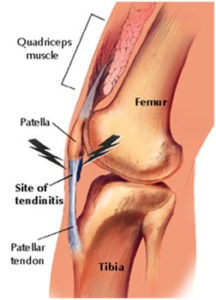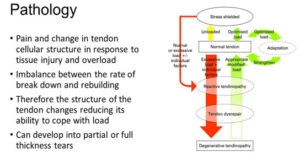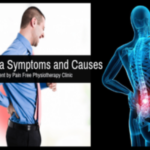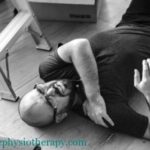What is Patellar Tendonitis /Tendinopathy?
Patellar tendonitis is an overuse injury affecting the patellar tendon which lies between the inferior pole of the patella and tibial tuberosity. Over-stress leads to inflammation of the tendon and is commonly known as Jumper’s Knee. Pain is typically located at the inferior pole of the patella. Patellar tendinopathy is a more severe form of the condition where degenerative features set in with a constitutional change in the tendon.

Patellar Tendonitis /Tendinopathy
The extensive use of the extensor mechanism of quadriceps muscles mainly in sports, especially those involving jumping, running, and kicking may lead to the problem. Excessive jumping and landing on flexed knee put tremendous strain on the patellar tendon. Initially, the damage may be minor and recover with adequate rest but if the tendon is repeatedly strained the damage may progressively become worse, causing pain and dysfunction and eventually irreversible change to the tendon matrix. The result is patellar tendinopathy.
The common sports in which patellar tendonitis is seen are basketball, volleyball, soccer, football, track and field running, high and long jump, tennis, dancing, gymnastics, and skiing.
In older people, the main cause of patellar tendinopathy is a result of degeneration that occurs due to repetitive micro-damage over time.
A Tendon Injury may occur at the following Three Junctions –
- Muscle-tendon junction
- mid-tendon area and
- bone-tendon junction
Non-insertional tendinopathies tend to be caused by a cumulative micro-trauma from repetitive overloading i.e. overtraining.
Phases of Tendinopathy
The tendon undergoes the following 4 stages of tissue adaptation on subjection to stress. While the 1st stage is considered essential for strengthening and maturity of the tendon rest of the stages are non-healthy with considerable/ irreversible change in the matrix of tendon making it less flexible to mechanical stresses and more susceptible to injury.
1. Reactive Tendinopathy
- Normal tissue adaptation phase to stress. The recovery is excellent with more strength and maturity in the tendon.
2. Tendon Disrepair
- The Injury rate exceeds the repair rate and as a result of complete recovery doesn’t occur.
- It is important to prevent deterioration with adequate rest and proper treatment or else it may progress to permanent changes/ cellular changes.
3. Degenerative Tendinopathy
- Permanent changes occur in the matrix of the tendon with cell death.
- Prognosis is poor in such cases.
4. Tendon Tear or Rupture
- Surgery is often the only option.

Causes
The factors that contribute to the development of patellar tendinopathies include:
- The rapid increase in the amount of training
- A sudden increase in training intensity
- Playing/training on rigid surfaces
- Tight quadriceps and hamstring muscles
- Poor lower Limb Biomechanics
- Poor foot posture, knee, or hip control.
Symptoms of Patellar Tendonitis
- Anterior knee pain around the inferior pole,
- Pain gets worse with provocating activities like jumping,
- Gradual onset of pain and can be related to increased intensity of sporting activity
- Tenderness over the inferior pole of the patellar tendon
- Often first worst thing in the morning is stiffness in the knee around the tendon,
- The affected tendon may appear thickened in comparison to the unaffected side
Symptoms of Patellar Tendinopathy
Tendinopathy usually causes pain, stiffness, and loss of strength in the affected area.
- The pain may get worse with knee movement
- Pain and stiffness more at night or early in the morning.
- Signs of inflammation (redness, warm, swollen and tenderness) may be present
- A crunchy sound or feeling while using the tendon.
Please seek professional advice to find out the exact stage of tendon pathology. The treatment may vary considerably depending on the stage of tendinopathy. Contact us to understand your problem better and undergo comprehensive and holistic treatment at our clinic.
DIAGNOSIS:
The condition can be clinically diagnosed with proper history taking. If the symptoms are severe and don’t improve with early treatment, a specific investigation may be requested, such as an ultrasound scan or MRI.
Treatment of Patellar Tendonitis /Tendinopathy
Initially, the treatment aims at settling the symptoms of tendonitis. The following things can be started right away at home.
- Rest the painful area, and avoid any activity that makes the pain worse.
- Apply ice 10-15 minutes every 2-3 hours, for the first 72 hours. Keep using ice as long as it helps.
- Do gentle range-of-motion exercises and stretching to prevent stiffness.
- Undertake an Eccentric Strengthen Program. This is vital!
In the acute phase, the primary aim is to control pain and inflammation. Electrotherapy modalities, icing, taping or de-loading braces are used for this purpose.
Relative rest is advised from aggravating activity in the early stages. Avoid activities that hurt the knee.
Stretching prevents reoccurrence so should be carefully incorporated in the treatment plan with proper advice from a physiotherapist.
As the pain gets better, the physiotherapist focuses on restoring patellar flexibility, full knee motion, strength, power and endurance, balance and proprioception, and agility training which should be individualized to one’s specific sporting or functional needs.
Note: TENDINOPATHIES RESPONDS BEST TO ECCENTRIC TRAINING PROGRAMME.





